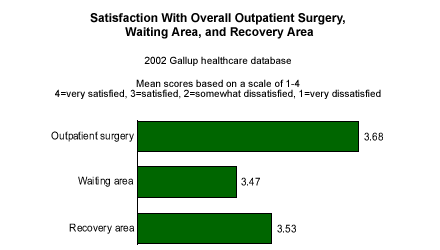To meet Americans' constantly growing healthcare needs, new outpatient surgery centers are continually opening across the country. Some centers are owned and operated by hospitals, others are sponsored by physicians or other entities. One might think that as these new centers spring up, older facilities would be at a competitive disadvantage when it comes to patient satisfaction. But how big a role does the facility itself really play in determining patient satisfaction with outpatient care?
Among the core outpatient surgery satisfaction items included in its healthcare database, ║┌┴╧═Ї asks two facility-related questions: satisfaction with the comfort and attractiveness of the waiting area, and satisfaction with the temperature and comfort of the recovery area.
Correlation between overall outpatient satisfaction and the comfort and attractiveness of the waiting area is low (.42) relative to the other aspects of care ║┌┴╧═Ї tracks, as is the relationship between outpatient satisfaction and temperature and comfort of the recovery area (.43). That's not to say that the two facility-related questions aren't important, but they are among the four lowest-ranked items when it comes to their impact on satisfaction with outpatient surgery.
Patient Satisfaction on Facility-Related Questions
According to 2002 findings from ║┌┴╧═Ї's aggregated healthcare database, just 50% of outpatient surgery patients were "very satisfied" with the comfort and attractiveness of the waiting area at their facility, and slightly more (57%) were very satisfied with the temperature and comfort of the recovery area. In comparison, 71% of patients said they were very satisfied with their overall outpatient surgery experience.
Mean satisfaction scores reveal the same variations. Based on a scale of 1 to 4, the mean score for overall patient satisfaction is 3.68, compared with 3.47 for satisfaction with the waiting area and 3.53 for satisfaction with the recovery area.

Impact of the Facility on Overall Outpatient Surgery Satisfaction
It is a common mistake to believe that renovating a facility or constructing a new one will automatically improve patient satisfaction scores. ║┌┴╧═Ї research indicates that this is most often not the case. If disengaged staff members and inefficient systems are simply moved to a new facility, satisfaction scores will remain low, if not decline. Good employees can earn high scores from patients regardless of the physical surroundings of the facility, while inefficient, unhappy workers can easily squander any advantages conferred by a sparkling, state-of-the-art facility.
However, a poor facility can act as a dissatisfier. Patients may not even notice that a waiting or recovery area is pleasant and comfortable, but they will certainly notice if the area is uncomfortable or distasteful in some other way. Healthcare facilities make an implicit promise to their patients that their waiting and recovery areas will be appropriate, and dissatisfaction will result if that promise is broken.
How to Improve Outpatient Facilities
The greatest potential for facility improvement lies in the waiting area. Facilities can improve substantially by focusing on the basics:
- Is the waiting area clean and uncluttered?
- Is the color of the area pleasing? Is it well-lit?
- Is the furniture comfortable and in good condition?
- Does the entry and exit of patients and visitors in the waiting areas cause unnecessary traffic?
- Are the bathrooms and access to food and drink well-marked and easily accessible?
- Are there activities available with which children can quietly entertain themselves?
- What can adults do to pass the time while they wait?
- Is the area cramped?
Over years of consulting with healthcare clients, I have spent many hours in outpatient surgery waiting areas. Typical waiting areas boast soap operas on a single television, old magazines, furniture past its prime, and a nearby hallway that creates chaos by funneling non-surgery patients through the area. Outpatient facilities should be most concerned with staff interactions with their patients -- but they could easily avoid actively producing dissatisfaction by providing a few basics, such as access to a warm pot of coffee and a clean bathroom.